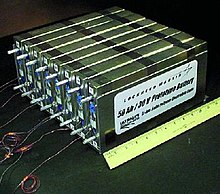Batteries[edit]
An electric-vehicle battery (EVB) in addition to the traction battery speciality systems used for industrial (or recreational) vehicles, are batteries used to power the propulsion system of a battery electric vehicle (BEVs). These batteries are usually a secondary (rechargeable) battery, and are typically lithium-ion batteries. Traction batteries, specifically designed with a high ampere-hour capacity, are used in forklifts, electric golf carts, riding floor scrubbers, electric motorcycles, electric cars, trucks, vans, and other electric vehicles.[75][76]
Efficiency[edit]
EVs convert over 59–62% of grid energy to the wheels. Conventional gasoline vehicles convert around 17–21%.[77]
Charging[edit]
Grid capacity[edit]
If almost all road vehicles were electric it would increase global demand for electricity by up to 25% by 2050 compared to 2020.[78] However, overall energy consumption and emissions would diminish because of the higher efficiency of EVs over the entire cycle, and the reduction in energy needed to refine fossil fuels.
You received this message because you are subscribed to the Google Groups "1top-oldtattoo-1" group.
To unsubscribe from this group and stop receiving emails from it, send an email to 1top-oldtattoo-1+unsubscribe@googlegroups.com.
To view this discussion on the web visit https://groups.google.com/d/msgid/1top-oldtattoo-1/CAMm_%2ByaTP_tU_%2BLYPYVWJ0%2BWt_xVgFR5fqLdUT2itV9N1Wt5gw%40mail.gmail.com.



No comments:
Post a Comment